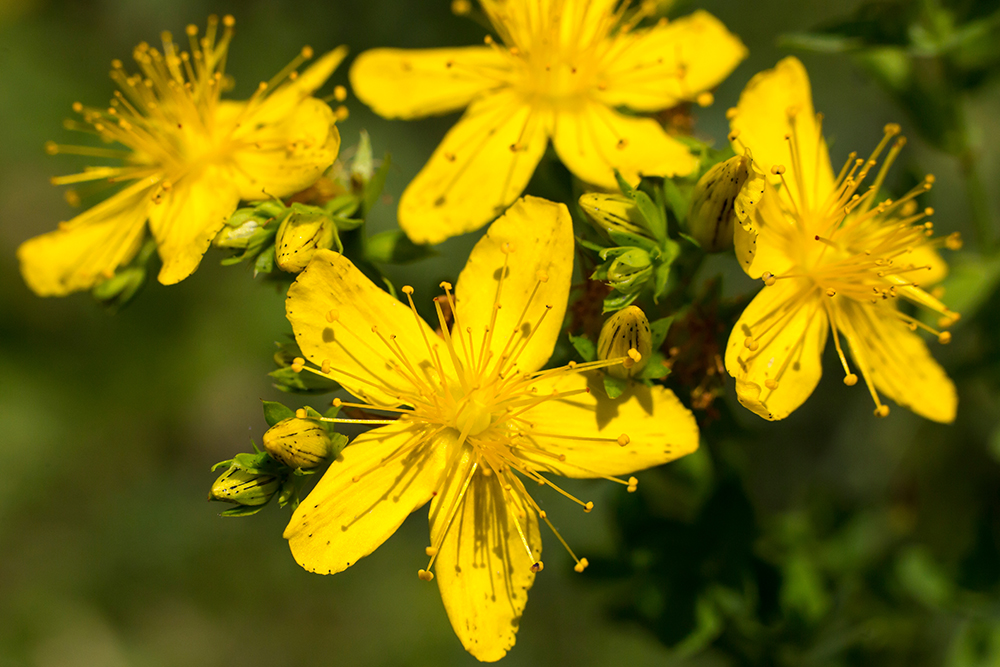Guest blog by Anne de Courtenay
I have a confession to make:
One of my favorite movies is “Godspell.”
Not the play, but the film from 1973, starring Victor Garber, who was once described by a friend of mine as “Never being really bad or really good in anything he’s been in.”
Well, I thought he was pretty great as the Superman/clown Jesus in the movie.
But you know which character intrigued me the most, got me thinking the most?
St. John the Baptist, played by David Haskell, who starred in the original Broadway musical.

From the movie Godspell: St John the Baptist gets bombed with flowers that look a lot like St. John’s wort by the apostles in an effort to get him to quit being so serious.
Today, June 24, is the Feast of St. John the Baptist, for whom the herb that blooms right around this time, St. John’s wort (Hypericum perforatum), is named.
During Lent and around this time of year when that incredibly solar-looking flower blooms, I think about St. John the Baptist, and what a complex figure he is. Filmmakers and artists tend to fetishize his execution, like to paint his head on a plate, like to juxtapose this gruesome fate with the capricious young seductress Salome, who danced for King Herod and demanded the head of the prophet as a price for her titillation of the ruler.
But there’s so much more to St. John the Baptist — not to be confused with the apostle and evangelist John, by the way; the John we are talking about now was not a follower. As a youth, he removed himself from his family and society to live alone in the desert, subsisting on locusts and honey, and wearing uncivilized garments.
I’m here to connect the medicinal herbs we study to story, so let’s consider this St. John who gives the plant its common name.
Twenty Feet from Stardom: Humility and Healing
St. John’s wort is so named because it blooms on or around St. John the Baptist’s feast day. June 24 was the feast date deliberately set six months before Christmas by the early Church fathers, because John, Jesus’ cousin, was said to be born about a half year before Jesus.
By now you’ve probably realized that this timing associates John with the height of the Sun’s light, now dwindling, and Jesus with the winter solstice, the longest night and the point at which the Sun’s light begins to grow. And so it is that John the Baptist’s most famous quote must be: “He (Jesus) must increase, but I must decrease” (John 3:30).
John coming ahead of Jesus also points to another way in which he was not a follower; he was actually a forerunner, someone born to not be the light but to prepare others to see it, if we stick to the Christian narrative.
All of this makes me wonder if he had to escape to the desert for most of his short life just so he could deal with coming thisclose to being the Messiah, so he could spend time alone getting his calling straight about what his life really meant.
Always the sandy hermit weirdo cousin with grasshopper breath, never the golden child! Might as well embrace it and do one’s part to get people ready for the real deal.
St. John’s wort is considered a noxious weed by some, but can be very hard to eradicate. The prophet himself, whose popularity was already considered a threat by authorities even before Jesus came along, was imprisoned for many months for denouncing Herod’s adultery. Meanwhile, his cousin was out and about giving sight to the blind and raising the dead and dining with tax collectors and prostitutes. Sitting in prison, John must have had his doubts — maybe Jesus really wasn’t the chosen one?
And here I think is a lesson we can receive from St. John’s wort specifically but about the healing process over all. John the Baptist’s work was devoted to clearing the way for the light to get through — yes, just like the herb’s action on melancholic states. But you can clear and clear the way until you see the only thing left is your own shadow; and then YOU have to step out of the way, too, for full healing to take place.
Herbalists complain, and rightfully so, about “compliance.” Sometimes we seek healing from plants but we can’t get out of our own way to health. We leave those herbs on the kitchen counter; we take them sporadically; we don’t take enough; we drink alcohol or stay up too late or put other things into our bodies that create more obstacles to the herbs’ actions. St. John’s wort is absolutely notorious for interacting unfavorably with many prescription drugs, especially those that affect mood. It really seems to require its own lane to sweep out the cobwebs, as well as a patient who’s really ready to commit to the long haul without interference, and where expectations are careful and considered.

St. John’s wort flowers.
A Summer Solstice Herb that Is Serious about Solar Power
St. John’s wort was traditionally an herb used to ward off evil spirits, and this is unsurprising, as its complete resemblance to the Sun with its rays shooting out of the center of the flower seems to carry the power to throw light into the darkest places. The power of the sun even suffuses through the plant’s leaves, which are pocked with tiny holes that let the light through (hence the second part of its binomial, perforatum). And, St. John the Baptist, a very holy and presumably chaste ascetic who could not even be seduced by Salome (as told by Oscar Wilde, anyway) surely would have the fortitude to put any demon into its place.
But these days, St. John’s wort is most often associated with driving away the dark spirits of depression. It is shown to be an effective aid for seasonal affective depression (again, note the lack of sunlight connected with this) and mild depression and anxiety. It’s probably not so useful for severe depression, however, whose dismantling is a task for more herbs and therapies than just one.
St. John’s wort holds a surprise for the uninitiated: squeeze an unopened bud and out comes a purple juice; macerate the flowers in oil and you receive a delightfully scented, ruby red unguent useful for scrapes, burns and especially nerve pain such as shingles. Here’s a link to a wonderful salve recipe by herbalist Ryan Drum, which makes use of fresh St. John’s wort and many other herbs you can find blooming or growing right now. Bonus — he includes pro tips on salve making, specific plant extraction and salve preservation.
Don’t go out in the Sun without SPF while you’re taking or applying St. John’s wort though; its photosensitizing properties make literal the prophet’s work of helping others “see the light,” which you’ll certainly notice as your skin suddenly burns a lot quicker in the sun’s rays.
Humility, discipline, knowing oneself, even stepping away into the wilderness for perspective; these are all essential steps for healing which come into stark contrast under the full power of the solstice sun on our life-giving planet who invites us into Nature so that we might know our own. I see these traits embodied in that mysterious saint who gave St. John’s wort its name, and whose full healing complement we’ve yet to unlock.

The popular names people assign to herbs can tell us much about their common use, appearance and the regard people have for them. With St johns wort (Hypericum perforatum) it flowers on or around the summer solstice, a sacred day for the pagan celebration which is also the time (June 24) that the church designated as the feast of St John the Baptist. Changing pagan holidays to Christian feast days was one of the methods used, deliberately or not, to turn ‘pagans’ into Christian converts. The same was probably true for late December, the time of the Winter solstice to Christmas. In fact, no one knows when either St John the Baptist or Christ was born.
The popular name, “St johns wort” probably occurred during the early days of the church. However, the binomial name, “Hypericum,” datng back to the early time of the Greeks, tells even more about the high regard ancient people had for this herb. “Hypericum” is a merging of two Greek words, “hyper” (meaning ‘over) and “eikon” (meaning ‘image’ or’ apparition’), referring to the plant’s supposed ability to ward off evil spirits. Even the not-fully-converted early Christians also clung to superstitions believing the plant to have magical powers.
I regard and use St. Johnswort as an antiviral, antibacterial herb with a unique affinity for the nervous system. Thus, it is good for inflammatory conditions but also for nerve pains such as peripheral neuropathy, spinal injuries, and of course mild depression. It has been found especially in high doses over a long period to interfere with several modern pharmaceuticals. St Johnwort oil made by macerating the chopped herb in olive oil turns a beautiful color red. It is a great topical oil for trauma, pain, and healing. One needs to be careful applying it externally as it is believed to cause light sensitivity.
While I happen to like the name St Johnswort, true or not, I think of St John the Baptist who lived in the desert to be close to nature and herbs. However, if you prefer you can simply call it hypericum.